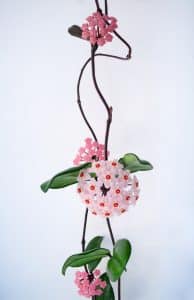If you like plants that make a statement in your house, you’ll fall in love with Hoya Linearis. Also known as Wax Plant or Wax Vine, this plant has a trailing growth pattern that makes it perfect for adding volume to your interiors. Also, its bright green foliage and fuzzy stems can create a curtain-like appearance if you grow your hoya linearis in hanging baskets.
Growing this plant might be slightly challenging at first. But don’t worry: we have your back! You’ll find all the information you must have on hand when deciding to get a hoya linearis in this essential guide! So, jump to the following sections to learn all about it.
| Botanical Name | Hoya Linearis |
| Common Name | Wax Plant or Wax Vine |
| Plant Type | Perennial |
| Flower Color | The plant produces clusters of fragrant white flowers lasting more than two weeks. The blooms have a star-shaped appearance. |
| Size When Mature | Up to 6.5 feet long. The length of its leaves can reach 2 inches. |
| Bloom Time | From Late Summer through Early Fall |
| Sun Requirements | Bright but indirect filtered light |
| USDA Hardiness Zones | 11-12 |
| Soil PH Range | Between 6.0 and 7.5 |
| Soil Type | Well-draining, moist, and fertile |
| Water Needs | Medium |
| Native Area | Tropical areas of the Himalayas |
What you Need to Know About Hoya Linearis
Native to the tropical areas of the Himalayas in Asia, this unique-looking plant is a stunning addition to any location. Unfortunately, it is challenging to find. So, if you can get your hands on one of these plants, don’t hesitate to take it!
Contrary to other Hoyas, the linearis variety has thin and slightly hairy foliage. So, don’t expect large and thick leaves from your plant! However, with its trailing growth habits and the tiny star-shaped flowers, this plant can spice up the looks of your interiors. Even if the plant is non-toxic, you should avoid letting your pets or kids munch on its leaves or stems. Hoyas produce a milky sap that can be irritable.
Because of its shallow roots, you must pay attention to your hoya linearis’ needs to grow a thriving plant. And to learn all about them, read the following sections!
How to Care for Hoya Linearis
To grow a healthy hoya linearis, you’ll need to recreate its natural conditions. And while there is nothing out of the world in this essential guide, we recommend you pay close attention to avoid any issues with your plant.
Light
Place your hoya linearis in a bright room with plenty of indirect light. Consider adding shears to protect your plant’s leaves from sunburn. Also, if you are not growing your hoya in a hanging basket, rotate your pot regularly to ensure an even growth pattern on all sides.
Water and Soil Needs
Following the proper watering schedule with your houseplant is crucial for its survival. However, you’ll have to use the right potting mix to avoid issues with overwatering. So, ensure your substrate is well-draining and fertile. For best results, you can prepare your organic potting mix by combining succulent soil, perlite, and orchid bark in the same ratio.
Alternatively, you can find potting mixes for hoyas and add some perlite to increase drainage. The ideal potting mix is airy, well-draining, and fertile. Also, it should have a pH between 6.0 and 7.5.
As a rule of thumb, you must water your hoya linearis only when the top few inches of the soil are dry. Doing so will prevent rotting and ensure healthy root development. Adapt your watering schedule to your local climate: you will have to reduce the frequency in the winter!
Temperature Requirements
Outdoors, a hoya linearis will survive in USDA hardiness zones between 11 and 12. However, you can also grow it as a houseplant if you keep it at temperatures between 60 and 85°F. Avoid exposing it to cold conditions: in most cases, a hoya won’t survive below 50°F.
Also, don’t forget to keep the environment humid: mist your hoya linearis’ leaves every couple of days to maintain the ideal conditions. If the climate is dry, consider investing in a humidifier!
Fertilizer
Hoya linearis isn’t a heavy feeder. However, applying a balanced product in the spring and summer will boost its growth. Dilute any product you purchase at half its strength to avoid burning your plant. Also, don’t forget to water the soil after the application: it will increase absorption!
Common Diseases
Too much sunlight or an improper watering schedule are the two most common issues with hoya linearis. So, ensure you know about your plant’s water needs and keep it away from direct sunlight exposure.
Also, keep an eye on aphids: they love hoyas. Take measures as soon as you notice them. Doing so will prevent infestations.

